Overview This is my attempt at a comprehensive ‘basic’ strategy guide for Warhammer. Warhammer requires that the player have a general strategy planed out when they pick their army and when they place units and terrain on the table. This is because units are much less maneuverable and therefore if placed in a bad location might never do anything of note. This is not meant to be army specific but will list which strategies work better for what army types.
I have attempted to include every generic strategy and unit type. Any comments are welcome and will be incorporates when I get the time.
note: Currently I havent managed to get the pictures to appear. If anyone knows how please let me know. Or go check the article out on dakka forums. It is up there with pics.
Unit Types Main units These are the main units of your army. How many of each and of what type goes a long way to determining how well your strategy will fare. These units should be foremost in your mind when you decide what you want to do in a battle.

The basic unit. Usually capable of matching only units of it’s caliber. This unit is used as a reference against all other units. This unit could be something as simple as empire swordsmen or ogre bulls. Both are fairly basic and both struggle to beat all basic infantry, bulls because they have no ranks and swordsmen because six strength 3 attacks wont cut it

The cannon fodder unit. Usually something such as skaven slaves or goblins this unit is weaker than even the basic unit. In combat this unit can be expected to never win combat and only hold against a depleted basic unit. It can however defeat units it manages to flank with some consistency. For the propose of this guide we will assume that all cannon fodder units will lose to anything they do not flank.

The superior unit. This unit is slightly superior to the basic unit. It might have an additional weapon skill or an extra +1 to its armor save. A small bonus such as this would allow it to beat the basic unit in combat consistently but not necessarily quickly. For the purposes of this strategy guide we will assume the superior unit will defeat the basic unit in 2 turns.

The anvil unit. This unit will hold against almost any attack. This unit could be either stubborn on a high leadership, unbreakable, or simply composed of models that are nearly impossible to kill (plague bearers are a great example of this). If your strategy, or countering your opponent’s strategy does not require an anvil unit then it can be considered to be a superior unit as it will beat basic units and many superior units in the long run. In some cases this unit can be easily beaten such as using fear to override stubborn or grinding the unit down with large amounts of units. For the purpose of this strategy guide we will assume all anvil units will hold out indefinitely against any unit except the hammer unit. Anvil units will be assumed to be on par with basic units in terms of combat potential.

The hammer unit. This unit will crush anything it is able to fight in combat. In some cases such as bretonians this only happens on the charge but in other cases such as chosen chaos knights this is always the case. These units are usually very expensive and small so any casualties from shooting or combat drastically weaken these units. For the purpose of this guide we will assume that hammer units will break anything they attack. Anvil units will take 2 turns. In the case of hammer vs hammer whoever has the advantage (flank or charge) will win.
A note on cavalry. All of the above units can be either infantry units or cavalry units. They are all represented. For the purposes of this strategy guide this will be ignored except where important.
Support units The following units generally do not make the strategy. They are only there to help the strategy succeeded. Therefore any strategy can incorporate these units. They should be used to remove the greatest threats to your chosen strategy (and by that I mean use them against the threats they work against).

The fast unit. This unit is usually a fast cavalry unit but not always (eagles and pegasi fit into this category as well). It moves considerably faster than most other units and ignores or moves around most obstacles in its way. The unit is not particularly competent in combat but if it manages a flanking attack it can usual break most non-hammer units and many times break hammer units with a little luck.

The shooting unit. This is any unit whose purpose is to shoot and not to fight. These units are usually pushovers in combat but can hold if they get flank charges of on basic or cannon fodder units. They can rarely do enough damage to completely destroy large units but they can whittle those units down so that they face a losing fight against what would have been their equal.
Skirmishers. These units are rarely there for fighting any combat unit. Their main jobs are getting in the way, hunting down lone wizards, hunting down war machines, and hunting down shooting units. In a pinch they can be used against fast units but not always. They are usually weak and only capable of taking on very weakened combat units. Skirmishers rarely form part of an army’s strategy. They are more of a harassment unit. They can also perform the same role as a fast unit or in stopping fast units. In this guide it is assumed that any skirmishers are performing war machine hunting or supplementing fast units. They will not be mentioned unless they are key elements.

War machines. These come in many shapes and sizes. Their job is to shoot and only shoot, never fight. Prime targets are hammer units, large units, and other war machines. Some however, are good at killing of fast units. They are very efficient at killing high point models as they usually wound everything just as easily. They can also be used to supplement shooting units if no other targets exist.
The generic big thing. This can represent anything from a giant to a lord on a dragon. Every one has a different purpose but most are capable of taking on hammer units or cannon fodder units but not basic units as the ranks and numbers will do them in eventually. In this strategy guide the unit will be ignored as it is to varied and not all armies have access to anything like this. They can take the place of hammer units or anvil units wherever necessary.
A note on characters. Their main purpose in this game is to support units. They can turn basic units into superior units or superior units into hammer units. They can take the form of shooting units as mages. They can also turn most units into anvil units through the use of a battle standard. Characters are not going to be mentioned unless necessary.
Many units can be combined to become a better unit. High elves are a prime example. Both elven chariots and elven cavalry are only superior units on the charge and almost cannon fodder when not charging. But when the two charge together they form a very powerful hammer unit. These combinations will not be discussed and you must incorporate them into your army on your own.
Other units vary their description depending on what they are facing. Dwarf warriors are an anvil unit against most basic and superior units. However, when faced with ogre iron guts they are just as easy to kill and about as dangerous as the average skaven clanrat. Just try to think of what your unit is capable of doing against your opponent before you commit to a strategy (sometimes your army selection will force the issue though).
There are a few special units such as the dwarves anvil or tomb king scorpions that do not fit into any category. This could be because like ogre lead belchers they are a hybrid unit or simply because they have a plethora of special rules. These will be ignored but can be fit into most strategies without to much effort.
Strategies In each case the strategy in question will be represented by the blue army attacking from below. Terrain will be left out at the moment and will be discussed later. Strategies will deal with both picking units for your army and general use of such units.
Basic strategy This is really a lack of a dedicated strategy. A basic army contains some of each element of the game. It contains a hammer unit, usually cavalry, an anvil unit, a couple war machines, a couple shooting units, a couple fast cav units, and 3-4 basic units. Oddly enough only two armies can really pull this off. Empire and orcs are the only two armies with access to all unit types. All other armies are missing at least one, usually more unit types.
Making the strategy work This strategy revolves around the fact that every army has a weakness and you have a unit that exploits that weakness. Your army also has a numerous supporting units to cover each other units weakness’s. It is all about using the proper tool for the job at hand and reacting correctly to your opponent. More than any other army this army needs to be deployed correctly. If you fail in this your shooting units will be to far away to see anything and your hammer unit will be lured into a pit of enemies it will never emerge from. Most army strategies are fairly set before they even hit the table. The basic strategy revolves around reacting to your opponent’s deployment and movement correctly.
It is generally best to start by deploying fast units on the flank. That is the best location for these unit types and they can go where they are needed very quickly. Anvil units can either go in the center to hold the line or on a flank to prevent your infantry from getting flanked, generally it is most important to put such units against his hammer unit/units so position them where this will be possible. Basic units should then go to locations across the line so there are no gaping holes. Shooting units go where they can deplete ranks of superior and hammer units in the enemy armies. War machines go where they can either see the battlefield or where they can get a flank shot or two off. Hammer units should usually go last on one flank or another. It is tempting to face your hammer unit off against the enemy’s equal in the center but this is usually a mistake because the game will come down to who’s unit won that fight and his is probably better. Never bet on dice rolls.
What follows is generic battle for a basic army type. The anvil moves forward to engage the opponent’s hammer. The hammer moves forward to break through the opponent’s lines and then wheel and flank the opponent’s hammer. The fast cav hunt down war machines and stop enemy fast cav from engaging the hammer. Shooting elements knock ranks off units so that other units can beat them more decisively.
Setup
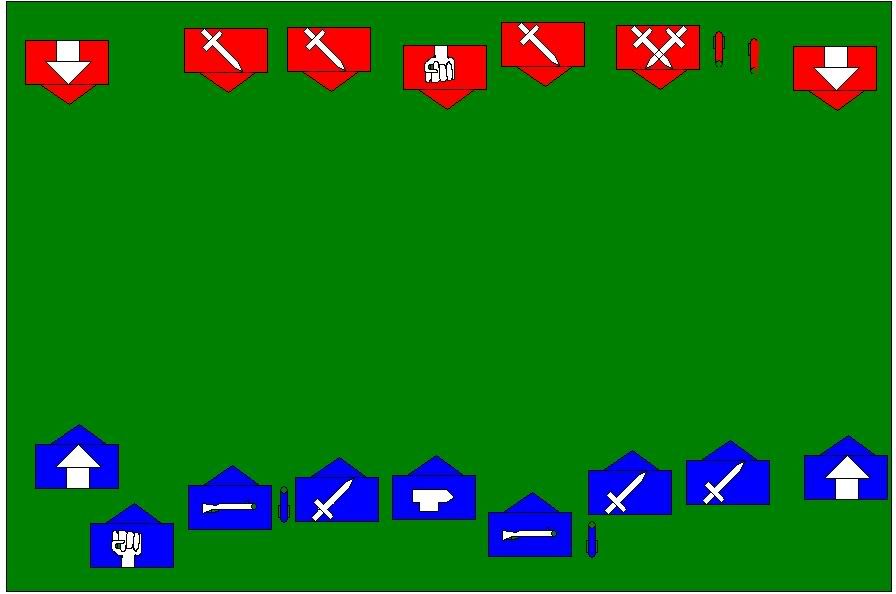
First 1-2 turns
Everyone advances, shooting units weaken the units on either side of the hammer.

Turns 3 or 4
Charges where possible. The fast unit on the right flank goes around its opponent and charges the war machines. The basic unit that charged on the left can easily defeat its weakened opponent.

Turn 5 or so
The advanced unit must charge something and it will flee as the other basic unit is now in position to kill the advanced unit.
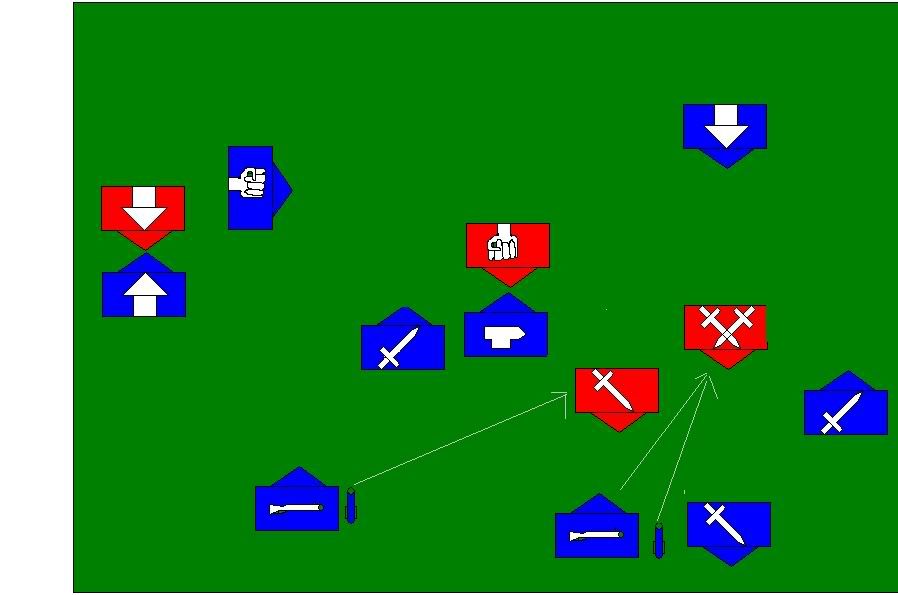
End Game
The opponent will end this game with 1, maybe two units.
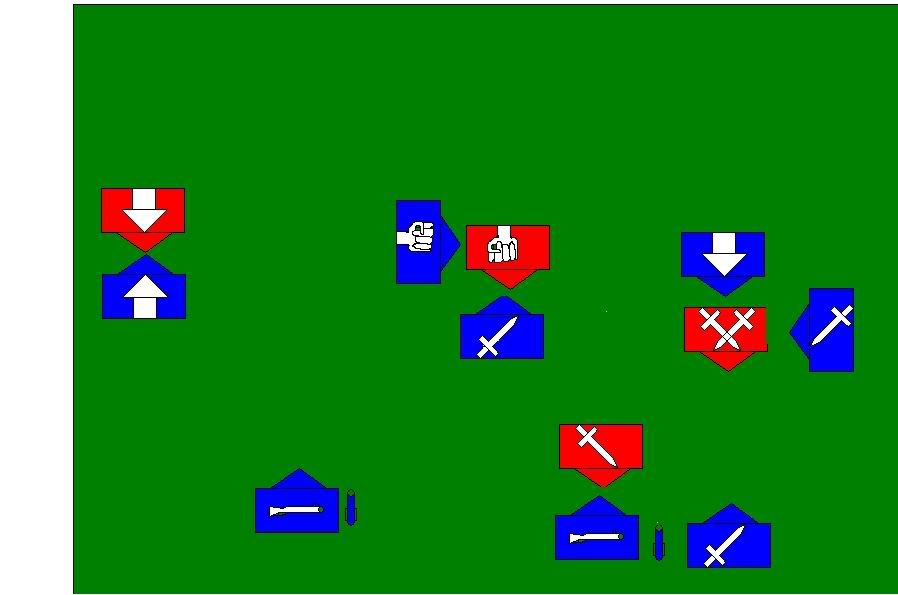 Defeating the Strategy
Defeating the Strategy The phrase “jack of all trades, master of none” is vastly overused in strategy discussions. However, it applies here. Basic armies have a little of everything but not many duplicates. If you can counter the units you have a counter to and avoid the ones you don’t you will do well. Failing that you can try to simply not let his units do what they are meant to do. If you can divert/stop/flank his hammer unit, neutralize the war machines, and block the anvil unit you are well on your way to winning. In the end it depends entirely on what you have. Your chosen strategy will do far more to dictate the flow of battle than the basic strategy and therefore it is difficult to give a generic method of winning.
The cavalry charge The cavalry charge is just what it sounds like. It is the most brute force strategy possible The army usually consists of multiple fast moving superior units and one or two hammer units, supported by fast moving units (fast cav/flyers). The army may contain a small amount of shooting support in the form of a war machine or two and might (usually not) have an infantry block or two. Bretonian armies and most current high elf armies epitomize this army but only dwarves are denied this strategy.
Making the strategy work There are three main ways people try to use this strategy.
One. Charge right down the middle. Usually this is a bad idea. In most cases your units are usually only vaguely better than his on the charge and significantly worse if the charge falters. Make sure you know the capabilities of your units before you charge in, five elven knights will not break ranked units on their own. You are going to be heavily outnumbered and easy to flank. However, sometimes it is required. Large amounts of shooting can force you to get your units into combat and out of the field of fire as quickly as possible. Terrain can also funnel you into the middle of the opponent’s lines. When this happens there is very little your hammer units can do to prevent them from going forward and into a very predictable charge. One cool trick you can use is to double charge units. If you can get multiple superior units to attack one unit you can break it easily even if it is a beefy combat unit in its own right. This can be tough with cavalry units as your frontage is quite wide. Bretonians and elves can pull it off as elves can put multiple chariots into a unit and one cavalry man with his corner touching to give numbers and banner bonuses. Another more useful trick is to charge multiple units. Many people will line their units up when they expect to get charged from cavalry. This gives them the best way of getting a flank charge off if their units hold. The rules state that if you charge one unit and another is within an inch of your front (not flank) it can be the target of the same charge. Use this to get three or four hammers against three or four of his units in one big combat. That way his ranks and banner and number only count once and your combat advantage counts 3 or four times.
Two. The flank charge. This is much the same as the previous strategy but with one change. You are two feet to one side or the other. This means that you will usually have roughly the same number of units as he does and your flank is protected by your strongest unit. Whatever number advantages he has will count for nothing.
Three: The delayed game. This one is rarely seen but particularly devastating. Cavalry armies can afford to hang back all game and chare on the bottom of turn 6. This means any damage they do will usually be enough to get them the game and there is no time to counter them. This is particularly brutal when the opponent doesn’t have enough shooting to thin you down. You can also pick off the weaker units in the early turns and set up flanking maneuvers in preparation for this mighty charge. For obvious reasons this strategy is hard to pull of vs fast armies.
No matter what cavalry tactic you chose there are some generic pieces of strategy that hold true. Two supporting units exist to help you.
Fast units are best used to kill enemy war machines and shooting units. Cavalry are very susceptible to casualties from such units and every model that dies will be sorely missed. If you have no such fast units than your weaker cavalry units can be used for this purpose. If you are successful in this early enough you can try for the delayed charge strategy and stand a good chance of winning.
Your shooting units, be they stone throwers or bolt throwers, are there to remove rank bonuses. Every rank that is removed is -1 to the enemies break test when you do charge. Very useful.
When determining if you should charge or not it is important to judge the outcomes. If you don’t break them on the charge you will break on their turn. Most of the time you will either need a rank and banner or support to break even basic units. Flanking fast cav, chariots, other cav units can all help make your victory more assured. Another neat trick that can be used against slower units such as dwarves is to bound off them multiple times. If you charge in once you probably will break in their turn. But you will most likely get far out of their charge range. Then if you rally in your turn you can charge back into the now weakened unit and have a good chance of beating them. In general, don’t charge unless you have a good (80% or so) chance of winning and breaking the unit OR you have a plan to compensate for failing to do so.
One thing to note. Don’t be afraid of fleeing from a charge. Your units generally only do well when charging so if the opponent manages to get a charge run away. Most cavalry units have high leadership and will rally in the next turn after getting far out of the unit’s charge range. This is a very simple method of preserving
VPs.
Here is a basic example
The cavalry deploy on one flank with the stronger units to the outside. Fast units to go both flanks to hunt shooting units.

Turn 1 everyone advances and turn 2 everyone charges their pre chosen targets. The basic unit in the center doesn’t charge so it an hold up the opponent’s hammer unit.

Turn 3 or 4. The units against the hammer units die easily and the basic unit left as bait stays to be sacrificed.
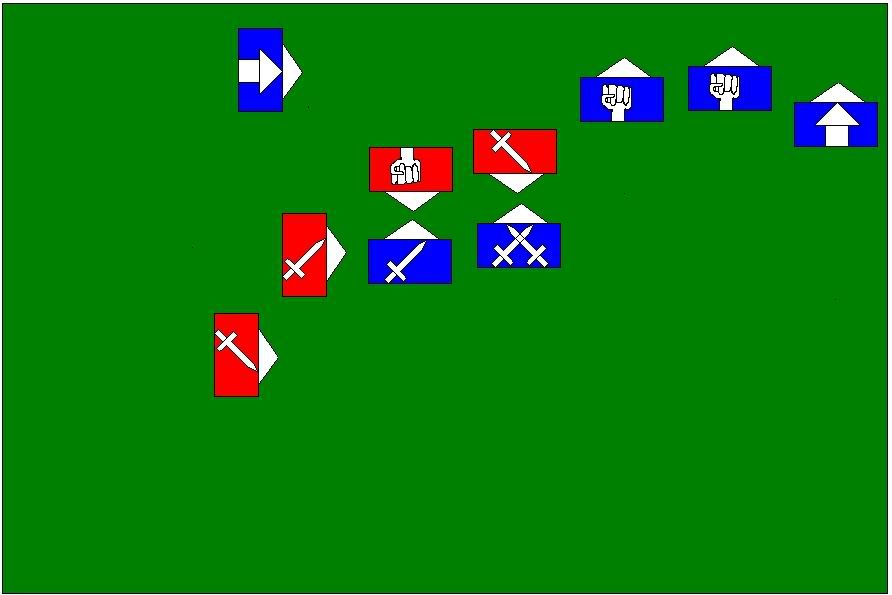
Turn 5 or so. The hammer units reposition for a final charge

Endgame: The red forces will be lucky to have one unit alive.
Beating the strategy Beating a cavalry charge is about stopping its momentum and counter charging. Use whatever shooting and fast units you have to stop his from killing your shooting units. They will then have 4 or so turns of shooting for free. Only do this if they can hurt cavalry, archers aren’t worth it. Every one else should try for a two deep formation. The cavalry will thunder through the line and you will be able to counter charge them easily. Only one or two units are usually needed for the counter charge as knights that aren’t charging are notoriously weak.
Think what would happen in the above example if the one basic unit that did nothing and the hammer unit held back on the first turns and simply turned so that when the opponent’s hammer units thundered through the flank they were then themselves flanked by a hammer and a basic unit. They would die easily.
Strong center For those of you who want multiple hammer units but don’t want an all cav army the strong center is for you. This usually involves multiple powerful units moving slowly down the center of the table. The army usually consists of 3-4 very powerful units, a few superior units and a few basic units. It might also contain a few fast units to help on the flanks. The most common armies to use this type are lizard men and ogres as the ogre’s speed and the lizard men’s magic and fast units make countering the strategy more difficult. Chaos and dwarves can make a good case for it but most players don’t attempt this.
Making the strategy work The strategy involves placing multiple hammer units in the center of the board with weaker and weaker units on the flanks. The major difference between this strategy and cavalry units racing up the center of the table is that your hammer units are slower and will still win most fights if they don’t charge. Basic units will go in front of the hammer units to act as shields and to redirect charges. Any fast units will either run up the side to flank the opposing army or will be placed in the middle to go war machine hunting. The line that is formed across the center can be either small and tight or wide with large gaps between units. The formation can also be off center to one side or the other but this is usually done when terrain forces it. It is best used when terrain can funnel the fight into a smaller area where your infantry can defeat the opponent’s. The sides of your formation should use their relatively cheaper infantry to try to flank any slower hammer units that come at your center.
Your main weaknesses are your flanks and enemy hammer units that can break your center on the charge. This is where any supporting units come into play. As mentioned the basic units supporting the center of your line can be used to divert any hammer units so that you can charge them, giving you the upper hand. Any that don’t get diverted will have their flanks threatened by the superior units you have. Threats to the flanks of your formation will also have to be dealt with by your superior units. If the flanking units are weaker then your flank can just face them and accept the charge as you will most likely win. If the flanking units are stronger you will have to divert them away from the fight with something.
War machines also pose a huge problem as your expensive hammer units are slow enough they will take quite a few shots before they see combat. Your army should always contain something to deal with this. Every army has options, just make sure to use it.
If your army contains shooting elements or war machines of its own then they should go on the flanks. As fast flanking units are the biggest problems to your strategy they should be the first to go and this is the spot to do it from.
Example:
The army setsup with the strong units in the center getting weaker to the flanks..
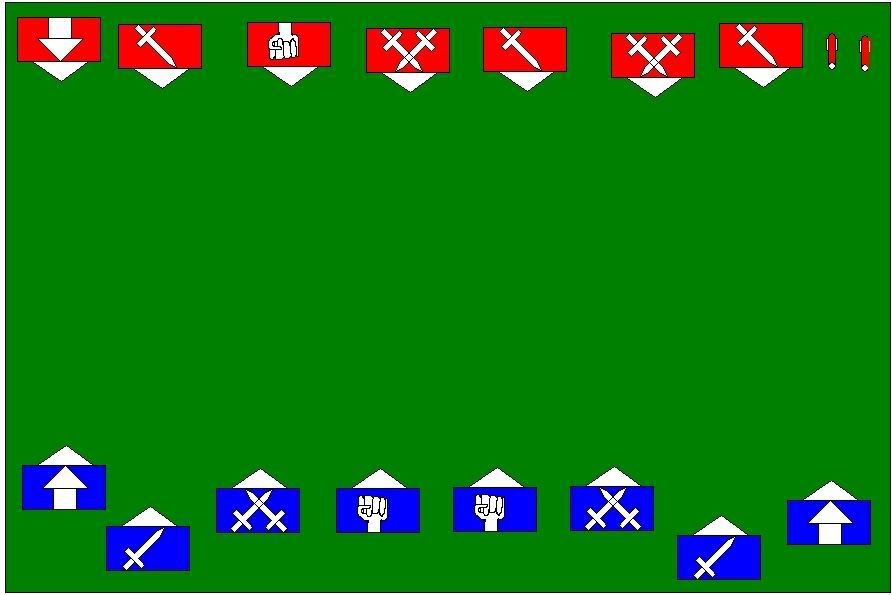
Turn 1 or 2. Everyone advances

Turn 3 and 4. The center charges, the flanks charge, and the other units try to create a standoff situation.

Turn 5 or so. The advanced unit flees from the hammer (no point giving away free points). The center punches through, and the standoff is finished as units come to support it.

Endgame the red forces will once again be lucky to emerge with even 1 unit alive.
Defeating the strategy Everyone always assumes you have to fight in the center of the board. You don’t. Everyone also assumes that at some time you have to try to kill the opponents huge 500 pt unit at some point in the game. You don’t. This strategy can be easily beaten by running down the flanks, flanking a few units here and there, picking off the weaker units, fleeing whenever your hammer units charge, and generally avoiding any fights that can’t be easily won. In general strong center armies are slower and therefore their hammer units rely on the basic units to get charges off and to avoid charges from enemy hammer units. Take this away from them and they will face a very tricky situation. If possible shoot out any unit that threatens your war machines and shooting units early. If this succeeds then you will have free rain to pick off his hammer units at your leisure. Just make sure it is possible before you commit anything to charging those units.
The refused flank The refused flank is a variation on the strong center strategy. The formation is moved to one flank or another and it contains an anvil unit of some kind. Usually the number of hammer units is reduced to pay for this anvil unit. Infantry heavy dwarves usually attempt this strategy. A few other armies also use variations on this strategy.
Making the strategy work The strategy works because it is extremely hard to flank. One flank is protected by the immovable table edge. The other flank is protected by the biggest anvil unit your army can afford. Between the anvil and the flank are the hammer units. In front of them are one or two basic units that perform the same function they did for the strong center and another unit or two to support the anvil (to keep it free to move after charges hit it). Other than that the only necessary thing is fast units to hunt down shooting units.
The usual plan is to walk forward and crush anything in the flank. As long as there is no shooting or it has been eliminated by fast units then the army will lose very little in terms of points. This means anything that is killed goes towards a win. army wins small victories, never crushing victories.
The benefit of this strategy over the strong center is that opponents have to face your hammer units head on. Unless they can do this (with the basic units to provide an additional challenge) they will have a very hard time killing anything.
The major obstacle is that if they have enough shooting on the opposite table side you will spend all game getting shot and killing nothing. As you deployed on the flank and not the center it will take your block infantry even longer to get to the shooting elements.
Any shooting units or war machines you happen to have should be used to thin down any unit that could take your hammer blocks on in a fair fight. The next biggest targets are units that are threatening your hammer unit’s flanks that cant be stopped by the anvil.
Example:
Setup, The anvil is protecting the flank of the formation. Fast units are positioned to run down shooting units.

Turn 1 or 2. Everyone advances. Opponent’s shooting units shoot something. It doesn’t really matter what.
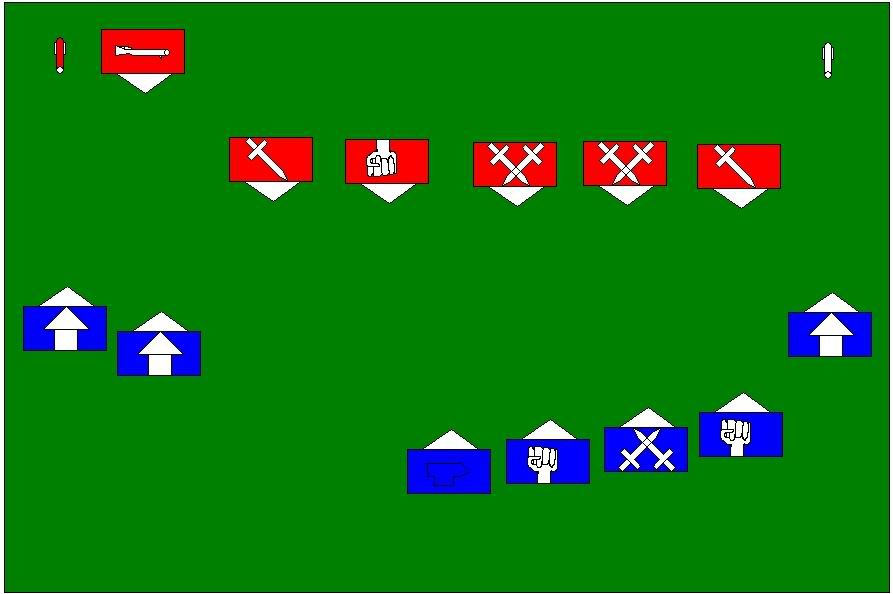
Turn 3 or 4 everyone charges. The lone basic unit sets up a flank charge.
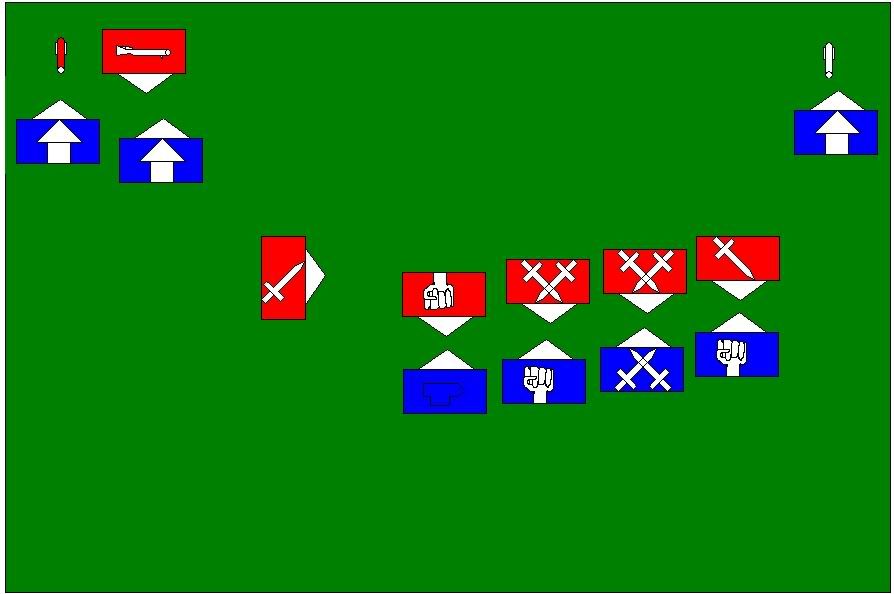
Turn 5 or so. If the hammer units hold after destroying their enemies they can flank the bigger blocks next to them. The fast cav can cleanup the wounded basic units.
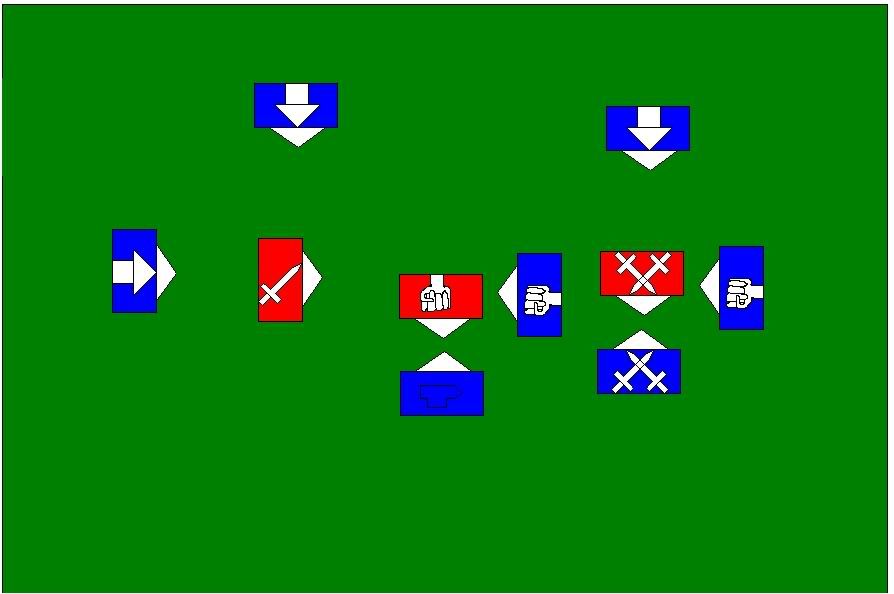
Endgame: The red forces will again be lucky to have one surviving unit.
Defeating the strategy Defeating the refused flank is tricky. There are three main ways.
Shooting. If you have a good shooting contingent you can shoot the army to pieces. Start on any fast units the opponent possesses then silence his shooting units, either with your own or with your fast units. At this point you can attempt to kill one or two expensive units at your leisure. Flanking them is difficult but can be done if you have enough of a movement advantage.
Break the anvil. Destroying the anvil quick enough to prevent your unit from getting flanked by its support is difficult. If you have a unit capable of this, fear being a good thing here, you can attempt that. Otherwise getting a flank charge on the anvil will hold it up long enough so that his hammer units cannot advance without exposing their flanks. This is the time to deal with any screening units those hammer units have. That way your opponent cannot charge whatever you just placed in front of his hammer without the hammer itself getting flanked.
Hammering the hammer. If you believe your hammer unit can crush his then, by all means, go crush. You will have to find some way around his screening units but that can be done with other units. If you go with this strategy you will either win or lose on the dice of that turn and charging is the most important thing.
Dual flanks, aka pincer This is really the opposite of the strong center. It consists of a few fast superior units racing down the flanks trying to get around an opponent’s flanks and some cheap basic units in the center to make sure the opponent doesn’t turn to face you. Every army except dwarves can do this fairly easily.
Making the strategy work The strategy revolves around fast moving hard hitting flanks. So make sure you have that covered. Two hard hitting units per flank are usually necessary which can get expensive. This usually means they will not stand up to true hammer units head on.
The flanks of your army need to advance as quick as possible. One unit per flank should deal with whatever is in its way leaving the other unit free to wheel towards the enemy’s battle line. It is important that this other unit not get diverted.
The center of your line should advance to just outside the enemy’s charge range. If your center gets charged and crumples your pincers will have killed a few cheap units and now be sitting in the middle of your opponent’s deployment zone while his hammer units killed something more valuable and he occupies your deployment zone. The units in the center of your line exist to prevent the opponent from turning to face your flanking attack and as such need to be able to stand up to basic units and defeat hammer units in the flank. You also need enough of these units to prevent one unit from coming out to deal with you leaving the rest of your opponent’s army to deal with your flankers.
Any shooting you have should aim for units that the opponent has placed on his flanks. This allows your flankers to accomplish their job faster. Once this is done you can then pound his stronger units in the center so your basic units can take them in a fight.
Example:
Setup: Faster superior units and fast units deploy in the flanks. Basic units deploy in the center.
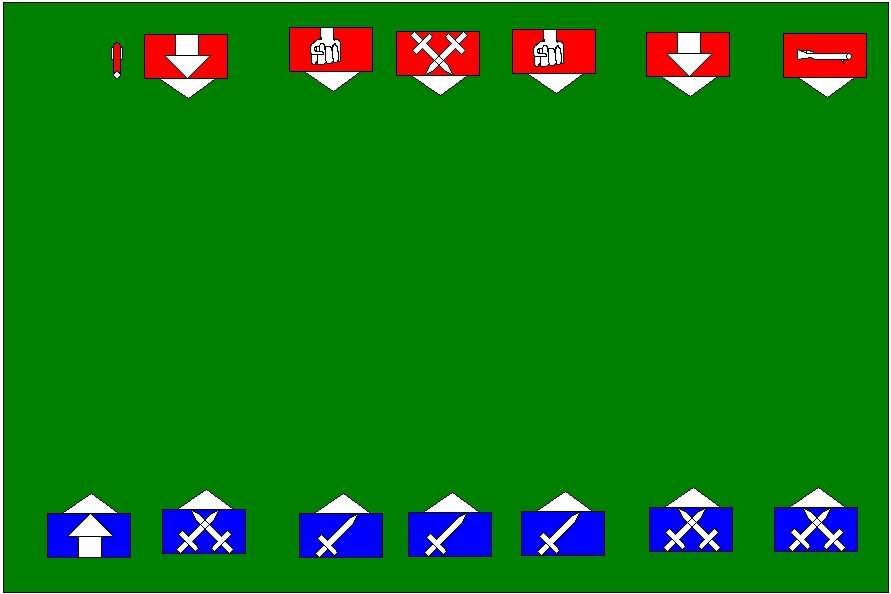
Turn 1 and 2. The faster units try to engage as quickly as possible, the middle advances a little.
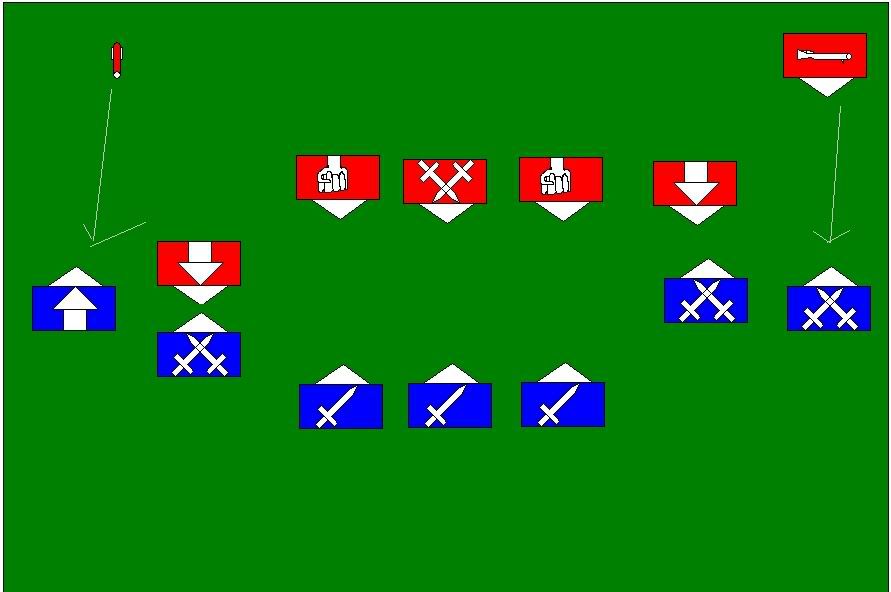
Turn 3 and 4. The flanking units start to turn inwards. The center units avoid battle and prevent the hammer units from turning outwards.

Turn 5 or so. The center units flee from hammer charges to get the hammer units into the proper position. They hold against the advanced unit to keep it in position for an overrun. If the hammer units had turned the basic units would have flanked them.
Endgame: Any way the center moves everything in the red army will die by the end of the game.
Defeating the strategy The flanks are the key to making this strategy work as well as the key to making this strategy fail. If your forces on the flanks can hold or destroy his forces then you can easily win. Towards this end use any shooting units you have to destroy his flankers or whittle them down until your own flanking units can defeat then. Use your fast units to threaten his units so that if they wheel towards the center you will get a rear charge on them. Use your basic/superior units to engage his middle. And position your hammer unit/units on the flanks to defeat any units (usually the more expensive units will be here) he is trying to flank with.
Horde armies A horde army is an impressive sight to see. It contains a couple superior units and 10+ basic units. The army can easily contain more than 250 miniatures. This army type is reserved for skaven, orcs, and occasionally empire (if they really want to).
Making the strategy work With an average amount of terrain eight units 100
mm wide with minor gaps between them can cover the entire board without leaving their flanks exposed. You other units can provide a second line of defense that you can stagger as needed. With all the models on the table you will rarely have a unit costing more than 200 pts. Add this together and you have an army that can’t be flanked, doesn’t care about losing anything, and can get a flank charge on anything that attacks it. With proper placement it is very hard for any unit to engage you without threatening its flanks. Always setup your army so that if something is charged it can flee and another unit can flank the charger, cannon fodder units to the front so they will be the first to get charged. Then advance along the whole front.
Unless your opponent also has a horde army then there will be weak spots in his defenses. Your basic units can usually punch through these defenses. Once this is done your army can start wheeling to encircle and destroy the opponent’s stronger units. Any hammer units in the opponent’s army should be treated exactly the same as every other unit. Bait and flee. If he doesn’t take the bait leave two units to pin him down and move everyone else on. Your advanced units should be placed somewhere where they can get to charge but nowhere near a hammer unit as they won’t win that combat.
The biggest threats to your army are things that cause panic checks and area affect weapons. These are your first priority. An empire mortar is a scary thing when it can’t miss. The next biggest threats are units that can make it around your flanks. Ideally this is not possible but some units can squeeze past or can go over you. You can also get flanked by units that can push through your flanks and wheel fast enough to still be able to threaten you later (bretonian cavalry are especially good at this). These units are your second priority. The last threat to your army is a truly beefy unit. The average 600 pt unit of death can deal with anything you throw at it no matter if it is a flank charge or not. Simply feed this unit cannon fodder because you will never be able to kill it. After that nothing really matters. You can win by making sure not to give up banners and to always have support for every unit.
Example:
The horde is deployed with its worst units defending the center and all other units arrayed around them.
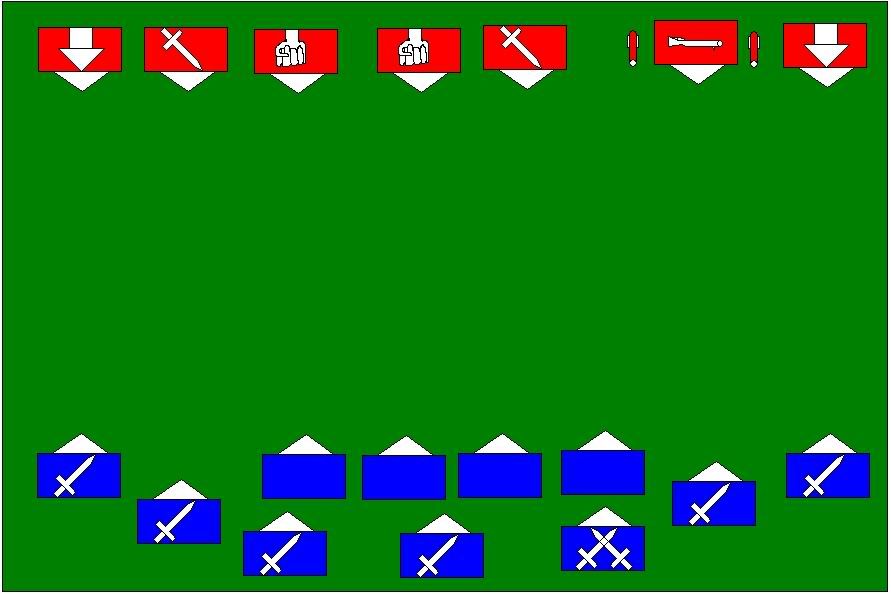
Turn 1 and 2. Everyone advances. The opponent’s shooting doesn’t matter as long as they don’t shoot the superior unit so cannon fodder is placed in their way.
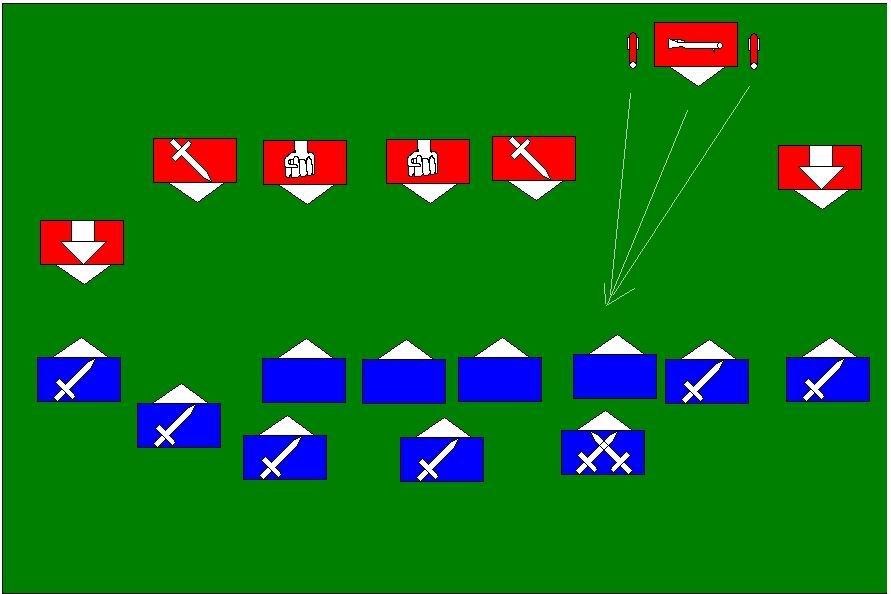
Turn 3 or 4. Charges are executed where needed and fled from when it is necessary to delay units. Flanks are setup.

Turn 5 or so:. The flanks start to move in. The far right flank moves up to crush the shooting units as even cannon fodder can take them in combat.

Endgame: The red forces might survive this with one hammer unit or they might not depending on things. Probably not.
Beating the strategy The only real weakness of the horde army besides the obvious flanks and panic is the horde army itself. You could try to bunker down and shoot out the army but since horde armies are so cheap you cant kill anything of value and they usually have 3-4 times that amount of war machine hunters that normal armies do. The advantage you will usually have is that every one of your units is better than every one of his units. Use this by trying to make him fight one on one instead of the usual 2 or 3 on 1 advantage horde armies manage to use. If you concentrate your entire army in a small area then the numbers will not matter as much as most of the horde cannot threaten you. Place all of your units in a tight formation, on a flank is best, and advance into his line. If you can execute a coordinated charge against a wide frontage at once time he cannot flee with everything as a large portion of his army would leave the table. Make sure to keep your flanks protected by leaving a unit or two on either side out of the charge to kill anything that comes your way and to block any flankers from charging you. Use shooting to soften up anything you think will hold on the charge to make breaking it easier.
Multiple Small Units / Multiple Small Elites This strategy is really similar to the horde strategy but instead of having lots of poor quality troops you have lots of superior troops but in small units (making them basic units). Dark elves are the predominate user of this strategy but many ogre players use it as well as some cavalry heavy high elves.
Making the strategy work The strategy works the same way a horde works. You advance along a broad front and try to punch through at a weak spot. If no weak spots exist you use your superior leadership to use bait and flank tactics. Because of the size of your units few of them will be able to take on fully ranked units or iron hard units. However, your speed will allow you to flank the enemy more easily and to exploit gaps in defense when they appear.
Beating the strategy The main weakness of a horde (panic) is far lower in a
MSU army. However, because of lack of ranks the resilience of a horde army is lacking in a
MSU army. This means that shooting units and thinning then down is very effective against
MSU armies. Also, any unit that fears ranked units will have less to fear from
MSU armies.
Other than this the normal methods of combating a horde army work very well. Present no flanks and keep your units together.
Gun line A gun line is exactly what it sounds like. It is an army that contains more shooting units than main units. It rarely moves and normally deploys on one side of the table or the other to minimize frontage. Empire and dwarf armies are the only ones that can really pull this off.
Making the strategy work When deploying make sure that every unit has a clear line of sight. Hills are great here. Guard your flanks with either terrain or an anvil unit. The only decisions after deployment you have are which units to shoot at. All other units should be dedicated to protecting your shooters. Towards this end shoot anything that can threaten your blocks in combat. Knock off ranks so that your units can deal with them quickly. It is usually a good idea to silence any enemy shooting but not always necessary. Generally, once your units are down that is it, nothing moves. One thing to note. Your army will be winning the first few turns hand down. Do not let this go to your head. The last turns when the enemy combat units arrive determine who will win this game.
Beating the strategy First of, the enemy will not move much. Therefore claim/contest every table quarter he does not occupy. Normally this doesn’t make a huge difference but against a shooting army these are free points. There are really only two armies that can beat a shooting army. Big armies (horde) and fast armies (cavalry). If you have an elite foot slogging army claim quarters and hide. You will have serious problems making it across the table. The two armies mentioned above should advance as fast as possible into the guns. Anything that makes it across the table can kill the shooting units. Hopefully you will have enough combat potential left to kill whatever defensive blocks he has left. That is basically all you can do.
The bigger challenge comes from gunline armies that have a few valid combat units. You cant really ignore these units as they are in the middle of the line. Generally, send your second string units to hold them up, your first string units will be beaten down by gunfire as they advance. Everyone else goes for the gunline units which are pushovers in combat.
The anti-strategy The anti strategy is really not a strategy. It is an assortment of units that can completely mess up any strategy. It usually involves many fast strong units that can go wherever they please and pick off isolated enemies. A wood elves army using dryads, war dancers, flyers, and fast cavalry is the best example.
Making the strategy work The strategy revolves around moving quickly to and striking from positions the enemy will have a hard time charging. This could be out in the flanks, in a forest, or in the middle of the table out of charge range. Generally it is a matter of target selection. Attack units you can beat and avoid units that can beat you. With your superior speed this shouldn’t be to hard. Your skirmishing infantry can move through terrain with no problems, use this to your advantage by forcing the opponent to guard every avenue of approach. Usually these army types have little to no shooting. Use it to soften up any units that could charge you such as fast cavalry or other skirmishers.
Beating the strategy Beating this strategy is aggravating. The opponent will set the game and decide where fights will take place. In most cases whoever charges will be the clear winner. If you can manage to get off charges then you can do well. Against this army type shooting does almost nothing as units are either skirmishers or one rank deep. If any good targets present themselves go for it. Depending on what army you have you can accomplish this different ways.
Fast armies: You should be able to out charge many units in the opponents army. Go for the ones you can, avoid the ones you cant. This will be tricky as your opponent’s army is better at this. The only advantage you will have is that your units are stronger and might resist a charge if hit head on. But don’t bet on it.
Horde armies: Deploy your army two or three units deep and advance like a roman porcupine. This way when the enemy charges you can flee and counter charge. This also prevents anything from getting into your formation to wreck havoc.
Elite armies: You have the glorious ability to take head on charges from much of the opposition. Defend your flanks and let them come as you will have a hard to impossible time getting any charges off that the opponent doesn’t want you to.
The all anvil army This is an oddity in the army warhammer world. Every unit or almost every unit is an anvil. Some armies that do this are strong in combat, some aren’t. This can be an undead army (mostly vampires) or a dwarf army. Nobody else can pull this off. Think slayer or necromancer armies.
Making the strategy work This army basically walks forward and hopes to engage the enemy on the front in much the same manner as the strong center strategy. Against all but the most powerful units you will eventually roll well and they will break. It is just a numbers game. Skeletons are particularly good at this as that one whiffed combat means your opponent will now break and you get to run him down because of fear and numbers. If the opponent gets a flank charge off this will not happen as your ranks and size count for nothing. You therefore want to advance along a small front and keep your flanks well guarded.
Beating the strategy This army is disaster hard to beat. Without a truly uber hammer unit to cut through an anvil you cannot take it head on. Even flanking the army isn’t a guarantee as anything that charges them will be stuck until one of the two units is dead to the man (many times it is yours). If you do not posses the uber hammer unit then run cheap units up to his units (a couple inches away) and flee from every charge. Then take your two or three best units and engage something on his flank using a flank and frontal combined charge. This should give you enough kills to win the combat eventually by either breaking him or just removing the anvil with meat-grinder like tactics. It will be a tough fight as the army just sits there and tries to nickel and dime you to death.
Using your chosen strategy So now you have your strategy planed out and you know how to defeat the opponent’s strategy. Which one do you do? Well the answer is obviously both. Every strategy can be adapted to utilize the basic counter strategies I have outlines. I cannot go into depth on every combination but I will give one example here.
Lets say you are playing a horde army against someone attempting a pincer strategy. Normally you would try to move forward and surround their center but this does you no good as the opponent’s points are all in the flanks. So to counter this you line up your infantry as normal but place your supporting units onto the flanks as opposed to the center. You now have two smaller battles to fight in exactly the same way you would previously have played the one large battle.
Last thought of the day:
If you have no strategy you will lose prety much every game against someone who does.
If you have your strategy but dont counter the opponenet's strategy (opponent does the same) you will have about a 50% chance of winning.
If you can employ your strategy and counter your opponent's strategy (oppoent doesnt try to counter you) you will win almost every game.
If both you and your opponent have strategies and counter strategies it will be an interesting game.